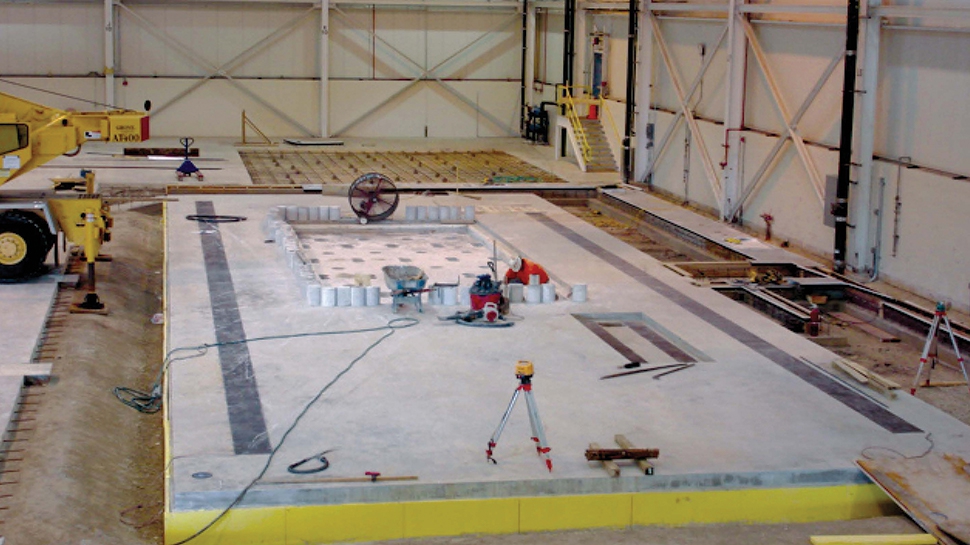
Boeing production facilities in St. Louis, Mo., needed a super-flat, dimensionally stable, crack-free and joint-free surface to operate a large, heavy precision friction stir welder. Type K shrinkage-compensating concrete was specified for the upper 2 ft. of thickness of the 32-ft.-x-86-ft. foundation slab. The slab included bearing areas, heavy I-beams cast into the concrete, and recessed areas. A monolithic placement and a super-flat surface were specified for this foundation slab in a pre-engineered high-bay metal building.
After reviewing the job conditions and performance requirements with CTS Cement, McCarthy and Metro Materials determined that Komponent® technology, used to create Type K shrinkage-compensating concrete, would produce the best results. Komponent was used to replace 15% of the portland cement in the mix design. The mix was then tested according to ASTM C878 to ensure adequate expansion to achieve a net-zero shrinkage using local aggregates and regional portland cement. After test results were submitted to Boeing, the company agreed to use Komponent based on the 14-day results, which indicated performance met specification requirements and would produce the same successful results Boeing had experienced at other facilities where Type K shrinkage-compensating concrete had been used.
By using the Komponent additive and blending it with regional portland cement, creating Type K cement at the production plant, the design and construction teams succeeded in reducing costs while providing a high-quality concrete floor slab solution.
Komponent was blown into a silo at the ready-mix plant and batching and mixing proceeded as usual. The resulting concrete had a 0.48 w/c ratio and was consistently at or near an 8-in. (203.2mm) slump, which allowed for easy pumpability and installation efficiency. A concrete boom pump was used for conveyance.
Placement of this 2,752-sq.-ft. (200-cu.-yd.) installation started at 6 am and was completed by 9 am. Because Type K concrete does not produce bleed water, finishing started immediately following placement and was completed by 1:45 pm. The hydration mechanism used by Komponent technology and its more complete consumption of mix water produces a low-permeability concrete with exceptional durability. The lack of bleed water prevents dilution of the cement paste at the surface and results in up to 60% greater abrasion resistance as well as the elimination of slab curling, spalling and corner breaks.
Wet curing using pre-soaked burlene and soaker hoses commenced immediately following finishing. The burlene and soaker hoses were used to keep the Type K concrete wet for the wet cure period. Wet curing ensures full expansion of the Komponent additive that is required to ensure net-zero drying shrinkage and results in minimizing or eliminating drying shrinkage cracks. The wet cure process did not interfere with ongoing construction activities and construction proceeded on schedule.
Ultimately, Boeing achieved the super-flat, dimensionally stable, crack-free and joint-free floor slab it needed; and Jacobs, McCarthy, CTS Cement, and Metro Materials delivered the specified performance.
For information on how Komponent® can be used to provide a high-performance shrinkage-compensating concreting or grouting solution on your next project, contact a member of the CTS Cement Engineering Team at (800) 929-3030 or info@CTScement.com.